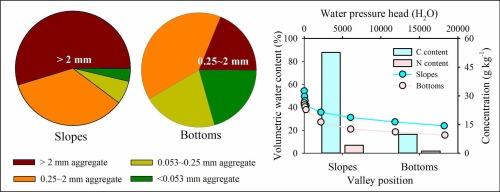热水河流域不同土地利用方式的土壤团聚体、碳氮含量和保水能力
IF 4.1
2区 环境科学与生态学
Q1 ECOLOGY
引用次数: 0
摘要
土壤有机碳(SOC)和全氮(TN)的积累和稳定以及土壤保水(SWR)对土壤的可持续性至关重要,特别是在干热河谷等脆弱生态系统中。然而,在热水河流域,土地利用对土壤稳定性、土壤团聚体有机碳和全氮含量以及农田容量(FC)、永久凋零点(PWP)和有效水量(AWC)的影响仍不清楚。2019年10月,采集了该地区山谷坡地(草地、灌丛地、林地)和谷底(裸地、灌丛地、农田:玉米休耕地和玉米菜地)不同土壤深度的土壤样品。结果表明,与山谷坡地相比,河谷底部的粘土含量、团聚体稳定性、有机碳、全氮和SWR均较低。在斜坡上,草地在稳定土壤结构和保持上层土壤水分方面优于灌丛和林地,特别是在0 ~ 30 cm深度,草地土壤的有机碳和全氮含量最高。在谷地底部,施肥增加了土壤有机碳和全氮含量,玉米-休耕土壤的2 mm团聚体比例、团聚体稳定性、FC和AWC均高于灌木地和玉米-蔬菜栽培土壤。谷坡草地和谷底玉米休耕地可能是稳定团聚体、促进土壤碳氮固存和保持水分的最佳选择。本研究为西南干热河谷生态恢复提供了理论依据。本文章由计算机程序翻译,如有差异,请以英文原文为准。

Soil aggregates, carbon and nitrogen content, and water retention across land uses in the Reshui River Catchment
Accumulation and stability of soil organic carbon (SOC) and total nitrogen (TN) as well as soil water retention (SWR) are critical for soil sustainability, especially in fragile ecosystems such as dry–warm valleys. However, land-use effects on soil stability, SOC and TN content of soil aggregates, and SWR properties, i.e., field capacity (FC), permanent wilting point (PWP), and available water capacity (AWC) across valley slopes and bottoms in the Reshui River Catchment remain largely unclear. Soil samples within different soil depths from valley slopes (grassland, shrubland, forestland) and bottoms (bare land, shrubland, cropland: maize-fallow and maize-vegetable fields) were collected in October 2019 in this region. Results showed that valley bottoms exhibited lower clay content, aggregate stability, SOC, TN, and SWR compared to valley slopes. On slopes, grassland outperformed shrubland and forestland in terms of stabilizing soil structure and holding soil water in the upper soil layer, especially at 0–30 cm depth, soils in grassland had highest SOC and TN concentrations within different aggregate fractions. At valley bottoms, cropland increased SOC and TN contents due to fertilizer input, and maize-fallow cultivated soils had higher proportion of > 2 mm aggregates, aggregates stability, FC and AWC than shrubland and maize-vegetable cultivated soils. Grassland on the valley slope and maize-fallow cropland at the valley bottom might be the optimum choices for stabilizing aggregates, boosting soil carbon and nitrogen sequestration, and holding water. This study provides a theoretical basis for the ecological restoration of southwest dry and warm valley.
求助全文
通过发布文献求助,成功后即可免费获取论文全文。
去求助
来源期刊

Ecological Engineering
环境科学-工程:环境
CiteScore
8.00
自引率
5.30%
发文量
293
审稿时长
57 days
期刊介绍:
Ecological engineering has been defined as the design of ecosystems for the mutual benefit of humans and nature. The journal is meant for ecologists who, because of their research interests or occupation, are involved in designing, monitoring, or restoring ecosystems, and can serve as a bridge between ecologists and engineers.
Specific topics covered in the journal include: habitat reconstruction; ecotechnology; synthetic ecology; bioengineering; restoration ecology; ecology conservation; ecosystem rehabilitation; stream and river restoration; reclamation ecology; non-renewable resource conservation. Descriptions of specific applications of ecological engineering are acceptable only when situated within context of adding novelty to current research and emphasizing ecosystem restoration. We do not accept purely descriptive reports on ecosystem structures (such as vegetation surveys), purely physical assessment of materials that can be used for ecological restoration, small-model studies carried out in the laboratory or greenhouse with artificial (waste)water or crop studies, or case studies on conventional wastewater treatment and eutrophication that do not offer an ecosystem restoration approach within the paper.
 求助内容:
求助内容: 应助结果提醒方式:
应助结果提醒方式:


